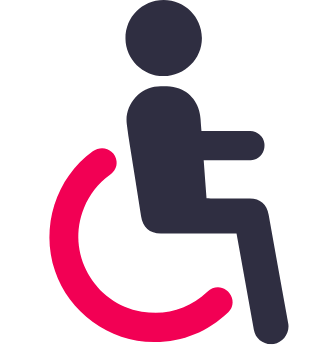5.2 Greeting a Candidate with a Disability
Read time:
2 min
 Interviewing a Person with a Visual Impairment
Interviewing a Person with a Visual Impairment
- When greeting someone with a visual impairment, introduce yourself and anyone else present.
- If you offer assistance, wait until your offer is acknowledged. Then wait or ask for instructions.
- If the person with a visual impairment needs to be escorted, invite them to take your arm at the elbow. Guide rather than propel the person, giving verbal directions along the way (e.g., “We are now going to walk through a doorway.”).
- Provide verbal directions about the location of the applicant’s chair.
- Let the person know if you move around or if you need to end the conversation.
- Let the person know if someone else leaves or enters the room.
- If a service animal is present, refrain from interacting with the animal.
 Interviewing a Person who is Hard of Hearing
Interviewing a Person who is Hard of Hearing
- If a sign language interpreter is present, they will usually sit beside the interviewer and across from the person with the disability.
- If the candidate who is hard of hearing lip reads:
- Look directly at them, and speak clearly at a normal pace.
- Do not exaggerate your lip movements.
- Do not shout.
- Speak expressively because the person will also rely on facial expressions, gestures and eye contact.
- If the candidate does not lip read, use brief notes or a sign language interpreter. Remember to direct your questions and interactions to the candidate – not the interpreter.

Interviewing a Person with a Mobility Issue
- Treat a wheelchair as part of the person’s personal space.
- Be aware that some wheelchair users may prefer to transfer themselves into an office chair for the interview.
- Enable people who use crutches, canes or wheelchairs to keep them within their reach.
- To facilitate conversation when interviewing a person who uses a wheelchair, sit in a chair that allows you to be at the person’s eye level.
Sources
1 Prospect. Employment-supported services and workplace capacity: Funded in part by the Government of Alberta. Retrieved from the Prospect website – Viable Program: Prospect - Break Barriers. Employ Change
Disclaimer:
Hire for Talent has made every effort to use the most respectful words possible while writing these materials. We realize, however, that the most appropriate terminology may change over time. We developed these materials with the intent to respect the dignity and inherent rights of all individual.
Hire for Talent has made every effort to use the most respectful words possible while writing these materials. We realize, however, that the most appropriate terminology may change over time. We developed these materials with the intent to respect the dignity and inherent rights of all individual.
This tool was developed in collaboration with
National Working Group


